|
Pioneer
Cemeteries and Their Stories, Madison County, Indiana |
 |
|
Pioneer
Cemeteries and Their Stories, Madison County, Indiana |
 |
aka Falls/Old Falls/Pendleton
Location: east side of Pendleton Avenue, south of CR 600S
 |
The old section of Grovelawn Cemetery is one of the largest burial grounds of early settlers in Madison County. To historians and genealogists, this section is better known as Old Falls Cemetery or Pendleton Cemetery. Located on the east side of bustling Pendleton Avenue, it is carefully maintained by the Grovelawn Cemetery Association which has newer, more modern sections on the west side of the avenue. Since Pendleton and the surrounding lands were the first in Madison County to be inhabited, Old Falls Cemetery is the resting place for many of the county's first families. (For more on Pendleton, go to Fall Creek Township page.)
|
One of the oldest
legible gravestones at Falls/Pendleton Cemetery is the one on the left in
the picture below, that
of Ann Jan Sam was born in New York in 1806 and learned the business of woolen manufacturing--carding, spinning, dyeing, cloth dressing. He and his father James came around 1830 to Fall Creek where they erected a large flouring mill in addition to a cloth factory. Brothers William and James were also in the milling business along the creek. "Mr. Irish was of a very enterprising turn and did a great deal toward developing Madison County... Generous hearted, open handed...during the war [Civil], many a barrel of flour has found its way to the needy without their knowing whose hand had bestowed it"; so testifies Harden. Five of Samuel's sons volunteered for the Civil War, and according to Harden: "Death came [to Samuel] before the war closed, and thus ended the life of one of the most prominent and best known men of Madison County." Samuel D. Irish was married three times, and these stones are among those in the large Irish family section.
|
|
|
|
|
A close-up of Ann Jane Irish's stone, above, reveals remarkably legible script: "In Memory of ANN JANE, Wife of SAMUEL D. IRISH. Daughter of Samuel and Lydia Phillips, born in Granville, O. died Dec. 23, 1834. And here found a resting place in the [arms] of her Lord." Brown stones of the 1830s and 40s, like this one, were granite, and granite retains carving extremely well. White stones became popular in the 1850s. Often of a softer, more porous type of marble, which made the ornate Victorian carvings easier to do, the lettering on these white stones, more often than not, has faded with time. Granite, of course, is what is used today. |
The well-kept white obelisk, above, records both Ann Jane and Samuel Irish's second wife Jemima Ann Baker, 1802-1854. |
|
Descendents have placed this stone to mark the grave of pioneer settler and businessman Thomas Silver. Thomas arrived in Pendleton as early as 1828/9 and "began the mercantile business," in other words, a general store supplying everyday necessities. Also at that time, Mr. Silver erected a frame mill on Fall Creek. (For more, go to the Fall Creek Township page.) This early entrepreneur was so successful that he was able to build at the corner of Main and State streets one of the first brick buildings in the county and once shipped a cargo of pork to Cuba (!). Thomas and his brother William (a Pendleton postmaster) are given the honor in Harden's history of being among the prominent attendees of the very first "old settlers' meeting" held between Pendleton and Huntsville circa 1856. Thomas Silver, early Pendleton "mover and shaker," was born in 1793 and died in 1873. |
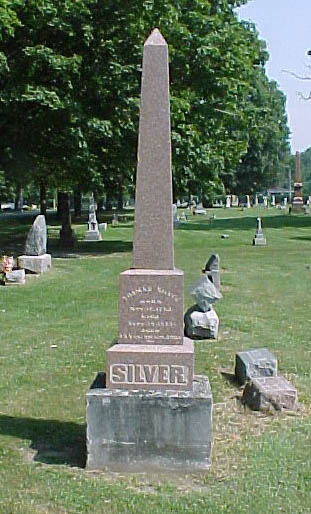 |
|
Almost lost to time is the interesting family information added to the bottom of Sarah Silver's gravestone, right. While the top has the customary details, "Sarah wife of Thomas Silver died March 9, 1845 aged 34 yrs. 1 mo. & 1 dy," the small script, barely legible and closest to the ground, states, "Mother of six children 2 buried by her side." To the immediate left of these lines is a familiar Victorian hand with index finger pointing to the earth--next to the stone and undesignated by any markers--wherein lay the bodies. |
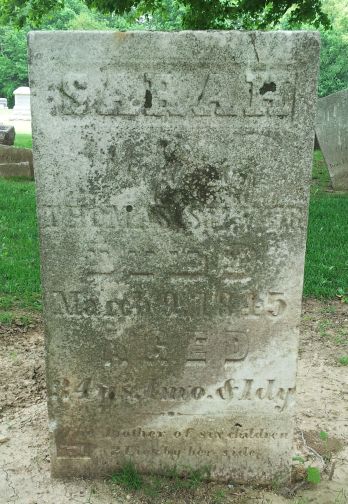 |
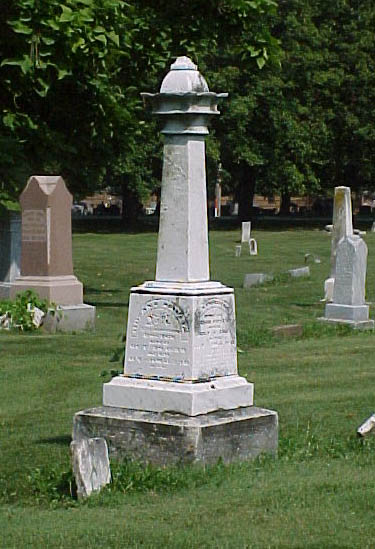 |
This attractive early Victorian marker is for Jesse Boston, 1788-1838, and wife Ann, 1785-1840. Jesse and brother Elijah Boston brought their families from Maryland via public conveyance to Cincinnati. From there, they traveled to Pendleton by wagons, arriving in the early 1830s. Jesse was one of the first prominent businessmen in Pendleton. He purchased Mr. Mingle's tavern to operate and built a large two and a half story, hewn log house to live in. Jesse's hotel/tavern was called the Madison House near Main and State streets, and it "numbered among its guests some of the principal...men of the county." Jesse was a shoemaker by trade, and his apprentice settled with the Boston family. Jesse and his apprentice kept a shoe shop in a little cabin and also had a thriving business there.
|
|
|
|
|
The large Prather/Prater family is recorded by Samuel Harden as among the early settlers to Stony Creek, Jackson, and Fall Creek townships. Members of the family started from Virginia, travelled through Wayne County, IN, before arriving here in the early 1830s. Buried at this location are two Nathans, a Henry, John, Amanda, Jane, and Mary M. among others. The two large, stylish markers, right, indicate that the family became very prosperous. Having one of the earliest legible markers in the county, above left, is Elizabeth Prater, "born Aug. 10, 1769 died Aug 10, 1835 Aged 66 years." Another, above right, is for Joseph Prater, "born June 10, 1769 died Feb. 28, 1836. From their birth dates, it is notable that both were children during the Revolutionary War. Descendants still reside in the area. |
|
|
|
For the Shaul family, patriarch Saul is specifically mentioned by Harden as entering one of the first tracts of land in the entire county. While he, along with four other members of the Shaul family, is buried at the Mt. Carmel Cemetery, various relatives are resting here at Grovelawn. The family marker, left, sits behind the individual members' stones lined in the front. The large red obelisk in the background right is also a Shaul monument. |
|
The Paveys, right, are related to American Revolutionary War soldier Samuel Pavey who, along with his wife Hethy, is buried at the Crosely Cemetery. There are over twenty of that surname resting here at Grovelawn including a second Samuel, 1842-1922. |
|
|
|
The pointed stone in the picture, left, is for Andrew Shanklin, 1805-1865. Mr. Shanklin held positions in local and state government. He settled in 1830 on Foster's Branch, three miles west of Pendleton. In 1840, he served as Justice of the Peace, was elected in 1850 as a member of the Constitutional Convention, and represented the county in the state legislature in 1852-53. A child's stone for "Emily" leans to the left, and a marker from mid 19th century once stood to the right. |
|
|
There are only four members of the Helvie family recorded on the burial list for this cemetery, but Leonidas contributed efforts in the Civil War as his government marker, on the right, indicates. He was in the "89 IND INF CO B." Relative Anna, on the left, was the "wife of G.P. Helvie." |
In the first row representing other first families are, far left, Emily Brown who died in 1844; center left, Joanna Davis who died in 1849; center right Mrs. Catharine Holliday Johnson who departed this life in 1852; and with scalloped curtains across the top of her stone Elizabeth Bates. In the second row, far left, Nancy Ireland died in 1840; Elum Ellison in 1849; the wife of Griffith Jackson in 1854; and "Catharine daughter of William and Leah Snell died Jan. 19, 1848."
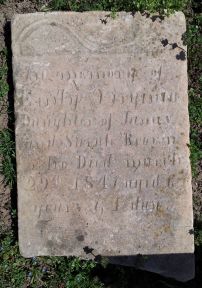
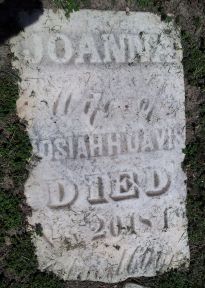
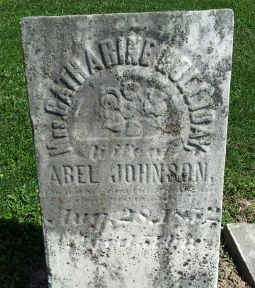




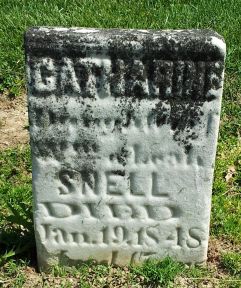
Some of the early settlers to Madison County were veterans from the Revolutionary War and the War of 1812. Over the decades, the United States government offered land, from newly acquired territory, to its veterans instead of a monetary payment. For this reason, much of what had been the New Purchase was pioneered and settled by family men who had first helped found a nation. Of the fourteen documented Revolutionary War veterans buried in the county, four of them rest in Grovelawn Cemetery, three in unmarked graves and one in a grave moved from the original private family graveyard. All four established families. The one veteran from the War of 1812 at Grovelawn has a known original burial site.
Elijah Boston, brother of Jesse Boston, above, is recorded as owning land in section 9 of Fall Creek Township. He was born in Maryland and was successful in the mercantile business there. At the beginning of the Revolutionary War, Elijah enlisted and eventually became an officer in his Maryland militia regiment. His service is recorded in Margaret Waters' DAR Supplement. Elijah Boston does not have a legible marker at Grovelawn, and it is assumed that he is buried in or near the family plot which is marked by Jesse’s pretty Victorian pillar (shown above).
Philip Hobaugh was born in 1763 and
enlisted in the Pennsylvania Militia for service in the Revolution. He
fought at Guilford and Eutaw Springs and was mustered out at Fort Pitt in
Novem ber 1783. He is listed in the DAR records. By 1804, he and his
wife Christine Huveum and children Molly, Michael, Elizabeth, Susannah, and
Peter were living in Ohio. The Hobaughs were among the early settlers to
Fall Creek Township. Philip served on a jury in 1825, and the family is
listed on the 1830 census. Philip Hobaugh died in August 1836.
ber 1783. He is listed in the DAR records. By 1804, he and his
wife Christine Huveum and children Molly, Michael, Elizabeth, Susannah, and
Peter were living in Ohio. The Hobaughs were among the early settlers to
Fall Creek Township. Philip served on a jury in 1825, and the family is
listed on the 1830 census. Philip Hobaugh died in August 1836.
William Wall was born in 1758 in Virginia and served in Taylor's Virginia Regiment. William's military service is documented in the DAR Index of Patriots. William's wife was Nancy Elkins and their two known children were John and Martha Ellen. John Wall would later own real estate in the Pendleton area, and a stone pillar marks the family plot at Old Falls Cemetery. Both Philip Hobaugh and William Wall are thought to be buried in or near their respective family's plot in the oldest section of Grovelawn pictured left.
Nathaniel Richmond is the patriarch of a family with several descendents of that name. Nathaniel has a DAR commemorative plaque and stone, placed by descendents, under the flag in the military section in the west half of Grovelawn. Nathaniel was born in Middleborough, Massachusetts, in July of 1763. He was a member of that state's 2nd Regiment and saw action at the battles of Valentine Hill and White Plains. His discharge was signed by George Washington, and he is listed in the DAR Index of Patriots. Nathaniel married Susannah Lombard in 1783. When Indiana first opened for settlement, he and his family moved in. He is first recorded in Dearborn County in 1818 and then in Fayette County in 1821. Sometime in the early 1820s, Nathaniel found his way to Pendleton and decided to stay there with his family. Several of his children are listed in the records of Fall Creek Township. Nathaniel died in September of 1829; his widow was still a resident a decade later.
From the War of 1812, veteran Stephenson Hair is listed by the American Legion as being buried in grave 5, row B, lot 41, block 2. His gravestone includes "KEIP Oh Mil." The Hair family is listed in Samuel Harden's The Pioneer as early settlers to Fall Creek Township.
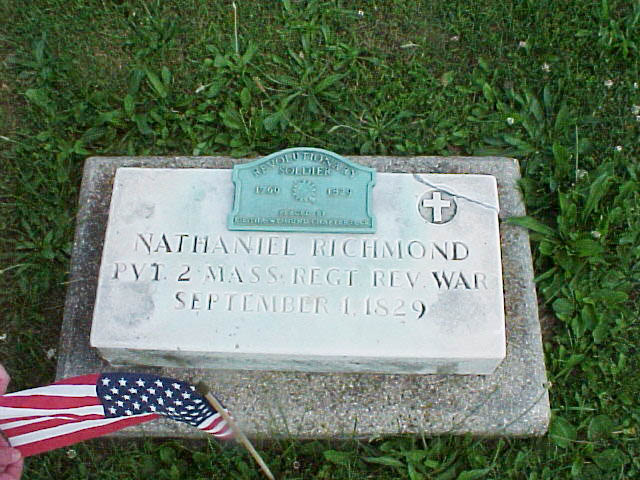 |
|
The DAR commemorative plaque and stone for Nathaniel Richmond is located under the American flag in the military section of Grovelawn. The cross in the corner of his stone indicates that he was a minister. Several of Nathaniel's descendents are also recorded as religious leaders. |
Click here for a list in .pdf format of burials with headstones.